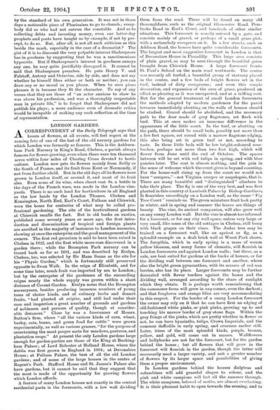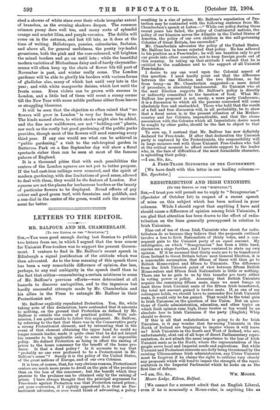ham Park Nursery in King's Road, Chelsea, a parish always
famous for flower-growing, even when there were ten thousand acres within four miles of Charing Cross devoted to horti- culture. London now gets its flowers mainly from Scilly or
the South of France, and its fruit from Kent or Normandy, if not from further afield. But in the old days all its flowers were grown in London itself, or around it, and most of its fruit also. Even some of its wine, when claret cost 8s. a bottle in the days of the French wars, was made in the London vine- yards. There is no such land for horticulture in all England as the low lands by the London Thames. Chelsea and Kensington, North End, Earl's Court, Fulham and Chiswick, were the home for centuries of what may be called pro- fessional gardening. The site of the horticultural gardens at Chiswick recalls the fact. But in old books on exotics, published some seventy years or more ago, the first intro- duction and dissemination of tropical and foreign plants are ascribed in the majority of instances to London nurseries, showing at once the enterprise and the good management of the owners. The first red geranium is said to have been raised in Chelsea in 1822, and the first white moss-rose discovered in a garden there ; while the Brompton Park nursery can be traced back as far as 1681, and was described by Evelyn. Chelsea, too, was selected by Sir Hans Soane as the site for his "Physic Garden," which is fortunately still preserved opposite to Swan Walk. In the reign of Elizabeth, and for some time later, much fruit was imported by sea to London ; but by the enterprise of the gardeners of the succeeding reigns nearly the whole supply was grown within a short distance of Covent Garden. Evelyn notes that the Brompton nurserymen, besides producing immense numbers of young trees of choice kinds, and of culinary herbs and dessert fruits, "had planted ab origin, and still had under their care and inspection a great number of grounds and gardens of noblemen and persons of quality, though at consider- able distances." Close by was a forerunner of Messrs. Sutton's firm, where " all the various kinds of corn, wheat, barley, oats, beans, and green food for cattle " were grown experimentally, as well as various grasses, "for the purpose of ascertaining the most proper sorts for meadows, pastures, and plantation crops." At present the only London gardens large enough for garden-parties are those of the King at Bucking. ham Palace.; of Lord Ilchester at Holland House, where the dahlia was first grown in England in 1804; at Devonshire House; at Fulham Palace, the best of all the old London gardens ; and of some of the large houses in the centre of Regent's Park. Stafford House and St. James's Palace also have gardens, but it cannot be said that they suggest that the most is made of the opportunity for growing flowers which London affords.
A feature of many London houses not exactly in the central residential parts is the forecourts, with a low wall dividing them from the road. These will be found on many old thoroughfares, such as the original Gloucester Road, Pem- broke Road in Earl's Court, and hundreds of other similar situations. This forecourt is usually entered by a gate, and consists mainly of gravel, or perhaps of a small grass plot, with a melancholy evergreen on it. In a few streets, such as Addison Road, the houses have quite considerable forecourts. The largest and most suggestive forecourt iu London is that of Devonshire House in Piccadilly. This large area consists of plain gravel, as may be seen through the beautiful gates brought from Chiswick House. A large forecourt fronts St. Paul's School on the main road westwards. The centre was recently all turfed, a beautiful group of statuary placed in the centre, and a few beds of bright flowers set in the turf, instead of dirty evergreens ; and even this simple decoration, and expansion of the area of grass, produced an effect as pleasing as it was unexpected, and at a trifling cost. But for the general treatment of small London forecourts the methods adopted by modern gardeners for the paved terraces immediately abutting on the walls of houses should be studied. Gravel should be abolished, and the necessary path to the door made of grey flagstones, set flush with turf. This at once makes an immense difference in the appearance of the little court. In the turf, or abutting on the path, there should be small beds, possibly not more than a few feet square, set round with a narrow flagstone edging, this also being set in green turf or not, according to taste. In these little beds will be low bright-coloured rose- bushes, perhaps not more than two feet high, which will flower from June until the end of October. The spaces between will be set with red tulips in spring, and with blue pansies later. The cost is almost. nothing, and the gain in the sense of welcome which the court gives is beyond counting. For the house-wall rising up from the court we would not have " creepers,"--not Virginia creeper or ampelopsis, that is. There are many beautiful and "distinguished" climbers to take their place. The fig is one of the very best, and was first planted in this country at Lambeth Palace by Bishop Gardiner. It flourishes exceedingly on a London wall, as the name "Fig Tree Court " reminds us. The green miniature fruit look pretty in winter, and in spring and summer the leaves are things of beauty. The vine, its ancient companion, will also grow well on any sunny London wall. But the vine is almost too informal for a forecourt, or for any city wall-space, unless very large or very small, like some of the old cottages in Chelsea, still hung with black grapes on their vines. The Judas tree may be trained on a forecourt wall, like an apricot or fig, as a splendid example on a drab brick wall at Wrest Park shows. The forsythia, which in early spring is a mass of waxen yellow blossom, and many forms of clematis, will flourish in London forecourts and against London walls ; but these, as a rule, are best suited for gardens at the backs of houses, or for the dividing wall between one forecourt and another, where also the bright green pyracanthus, with its masses of red wax berries, also has its place. Larger forecourts may be further decorated with flower borders against the house and the dividing wall, arranged according to the share of sunlight which they obtain. It is perhaps worth remembering that the commoner ferns will grow in any corner, even the darkest; and that foxgloves and orange lilies are very accommodating in this respect. For the border of a sunny London forecourt the owner may rely on it that he can have first an edging of old-fashioned white pinks, or pink pinks, growing up to and touching his narrow border of grey stone flags. Within the grey fringe of the pinks, which are pretty whether in flower or not, he can have hyacinths, tulips, Crown Imperials, and the common daffodils in early spring, and crocuses earlier still. Later, irises of the most splendid kinds, purple, bronze, yellow, and gold, will come out in masses. Wallflowers and hollyhocks are not for the forecourt, but for the garden behind the house ; but all flowers that will grow in the forecourt will flourish in the garden, though the latter will necessarily need a larger variety, and suit a greater number of flowers by its larger space and possibilities of giving them a proper environment.
In London gardens behind the houses dielytras and columbines will add graceful shapes to colour, and the pink and white campions will last all the summer through. The white campions, beloved of moths, are almost everlasting. It is their pleasant habit to open towards the evening, and to shed a shower of white stars over their whole irregular extent of branches, as the evening shadows deepen. The common crimson peony does well too, and many sorts of splendid orange and scarlet lilies, and purple veronica. The dahlia will come on in the autumn, and last till late, as it does at the time of writing. Heliotropes, pansies, calceolarias, fuchsias, and above all, for general usefulness, the pretty ivy-leafed geraniums, both the pink and the rose-coloured, will brighten the mixed borders and go on until late ; while the beautiful modern varieties of Michaelmas daisy and of hardy chrysanthe- mums will often keep up the chain of flower life till part of November. is past, and winter really come. The London gardener will be able to glorify his borders with various forms of gladiolus also, many of which last until very late in the year; and with white marguerite daisies, which last until the frosts come. Even violets can be grown with success in London, and a little bed of them will scent a sunny corner till the New Year with some subtle perfume either from leaves or straggling blossoms.
It will be seen that the objection so often raised that "no flowers will grow in London" is very far from being true. The kinds named above, to which stocks might also be added, and the fine new wallflowers, are not " bedding-out " plants, nor such as the costly but good gardening of the public parks provides, though most of the flowers will need renewing every third year. If any one would see what can be achieved in " public gardening," a visit to the sub-tropical garden in Battersea Park on a fine September day will show a floral spectacle richer than can be seen at most of the famous palaces of England.
It is a thousand pities that with such possibilities the centres of the London spiares are not put to better purpose. If the bad cast-iron railings were removed, and the spirit of modern gardening, with due limitations of good sense, allowed to deal with them, they would be the feature of London. But squares are not the places for herbaceous borders or the beauty of particular flowers to be displayed. Broad effects of gay colour and good green turf, with fountains and goldfish, and a sun-dial in the centre of the green, would suit the environ- ment far better.











































 Previous page
Previous page